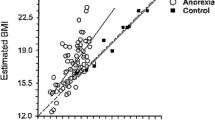Abstract
High and low weight-preoccupied women were instructed to imagine themselves in situations described by ambiguous sentences related to body size. These ambiguous sentences could be interpreted in either a positive or negative manner. In a subsequent recognition memory test, subjects highly preoccupied with body weight were found to recall their imagery of the body-related situations with a negative interpretation. The interpretation of imagery to ambiguous performance and health-related situations was found to be unrelated to weight preoccupation. These findings suggest that interpretational biases may be a result of processing information which is of emotional concern to the individual, and that the biased interpretation of ambiguous body-related stimuli may function to maintain excessive preoccupation with body size.
Similar content being viewed by others
References
American Psychiatric Association (1987).Diagnostic and statistical manual of mental disorders (3rd ed., rev.). Washington, DC: Author.
Arkes, H. R. (1991). Costs and benefits of judgement errors: Implications for debiasing.Psychological Bulletin, 110, 486–498.
Beck, A. I., Ward, C. H., Mendelson, M., Mock, J. E., & Erbaugh, J. K. (1961). An inventory for measuring depression.Archives of General Psychiatry, 4, 561–571.
Ben-Tovim, D. I., Walker, M. K., Fok, D., & Yap, E. (1989). An adaptation of the Stroop test for measuring shape and food concerns in eating disorders: A quantitative measure of psychopathology?International Journal of Eating Disorders, 8, 681–687.
Burkes-Miller, M. E., & Black, D. R. (1991). College athletes and eating disorders: A theoretical context. In D. R. Black (Ed.),Eating disorders among athletes (pp. 11–26). Reston, VA: American Alliance for Health, Physical Education, Recreation and Dance.
Cooper, P. J., Taylor, M. J., Cooper, Z., & Fairburn, C. G. (1987). Development and validation of the body shape questionnaire.International Journal of Eating Disorders, 6, 485–494.
Crowne, D. P., & Marlowe, D. (1960). A new scale of social desirability independent of psychopathology.Journal of Consulting Psychology, 24, 349–354.
Eysenck, H. J., & Eysenck, S. B. G. (1975).Manual of the Eysenck Personality Questionnaire. San Diego: EDITS/Educational and Industrial Testing Services.
Eysenck, M. W., Mogg, K., May, J., Richards, A., & Mathews, A. (1991). Bias in interpretation of ambiguous sentences related to threat in anxiety.Journal of Abnormal Psychology, 100, 144–150.
Garner, D. M., & Olmstead, M. P. (1984).Manual for the Eating Disorders Inventory (EDI). Odessa, FL: Psychological Assessment Resources, Inc.
Garner, D. M., Olmstead, M. P., Polivy, J., & Garfinkel, P. E. (1984). Comparison between weight-preoccupied women and anorexia nervosa.Psychosomatic Medicine, 46, 255–266.
Garrow, J. S., (1983). Indices of adiposity.Review of Clinical Nutrition, 53, 697–708.
Haaga, D. F., Dyck, M. J., & Ernst, D. (1991). Empirical status of cognitive theory of depression.Psychological Bulletin, 110, 215–236.
Kellner, R., Abbott, P., Winslow, W. W., & Pathak, D. (1987). Fears, beliefs, and attitudes in DSM-III hypochondriasis.Journal of Nervous and Mental Disease, 175, 20–25.
Martens, R. (1977).Sport Competition Anxiety Test. Champaign, IL: Human Kinetics.
Martens, R., Vealey, R. S., & Burton, D. (1990).Competitive Anxiety in Sport. Champaign, IL: Human Kinetics.
McNally, R. J. (1990). Psychological approaches to panic disorder: A review.Psychological Bulletin, 108, 403–419.
RightSoft Inc. (1989).RightWriter (Version 3.0). Sarasota, FL: Author.
Rosen, J. C., & Reiter, J. (1991).Body Dysmorphic Disorder Examination. Unpublished manuscript.
Schlundt, D. G., & Johnson, W. G. (1990).Eating disorders: Assessment and treatment. Boston: Allyn and Bacon.
Schotte, D. E., McNally, R. J., & Turner, M. L. (1990). A dichotic listening analysis of body weight concerns in bulimia nervosa.International Journal of Eating Disorders, 9, 109–113.
Sebastian, S. B., Williamson, D. A., & Blouin, D. C. (1995).Explicit memory bias for body-related stimuli in the eating disorders. Manuscript submitted for publication.
Spielberger, C. D., Gorsuch, R. L., & Lushene, R. E. (1970).Manual for the State Trait Anxiety Inventory. Palo Alta, CA: Consulting Psychologists Press.
Tobin, D. L., Johnson, D., Steinberg, S., Staats, M., & Bennis, A. B. (1991). Multifactorial assessment of bulimia nervosa.Journal of Abnormal Psychology, 100, 14–21.
Vitousek, K. B., & Hollon, S. D. (1990). The investigation of schematic content and processing in eating disorders.Cognitive Therapy and Research, 14, 191–124.
Williamson, D. A. (1990).Assessment of eating disorders: Obesity, bulimia, and anorexia nervosa. New York: Pergamon Press.
Williamson, D. A., Barker, S. E., Bertman, L. E., & Gleaves, D. H. (in press). Body Image, Body Dysphoria, Dietary Restraint: Factor structure in nonclinical subjects.Behaviour Research and Therapy.
Williamson, D. A., Cubic, B. A., & Norris, L. E. (1993). Etiology and management of eating disorders. In P. B. Sutker & H. E. Adams (eds.),Comprehensive handbook of psychopathology (2nd ed.). New York: Plenum Press.
Williamson, D. A., Davis, C. J., Goreczny, A. J., Bennett, S. M., & Gleaves, D. H. (1989). Development of a simple procedure for assessing body image.Behavioral Assessment, 11, 433–446.
Williamson, D. A., Sebastian, S. B., & Varnado, P. J. (in press). Anorexia and bulimia nervosa. In A. J. Goreczny (ed.),Handbook of health and rehabilitation psychology. New York: Plenum Press.
Author information
Authors and Affiliations
Additional information
We gratefully acknowledge the assistance of David Blouin in the design and statistical analyses of this study. We thank Andrew Mathews for his help with the design and conceptualization of this study. We would also like to thank Mark Warner and Andy Gill for their assistance in working with Louisiana State University athletes.
Rights and permissions
About this article
Cite this article
Jackman, L.P., Williamson, D.A., Netemeyer, R.G. et al. Do weight-preoccupied women misinterpret ambiguous stimuli related to body size?. Cogn Ther Res 19, 341–355 (1995). https://doi.org/10.1007/BF02230404
Issue Date:
DOI: https://doi.org/10.1007/BF02230404




